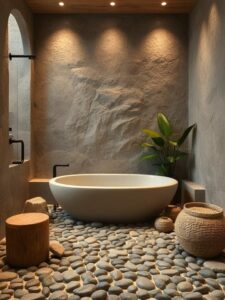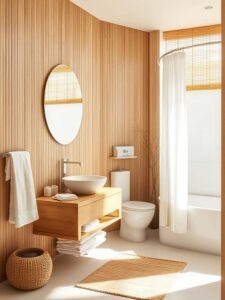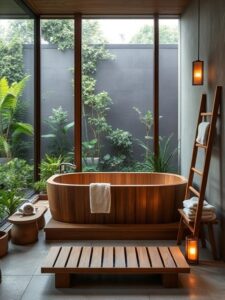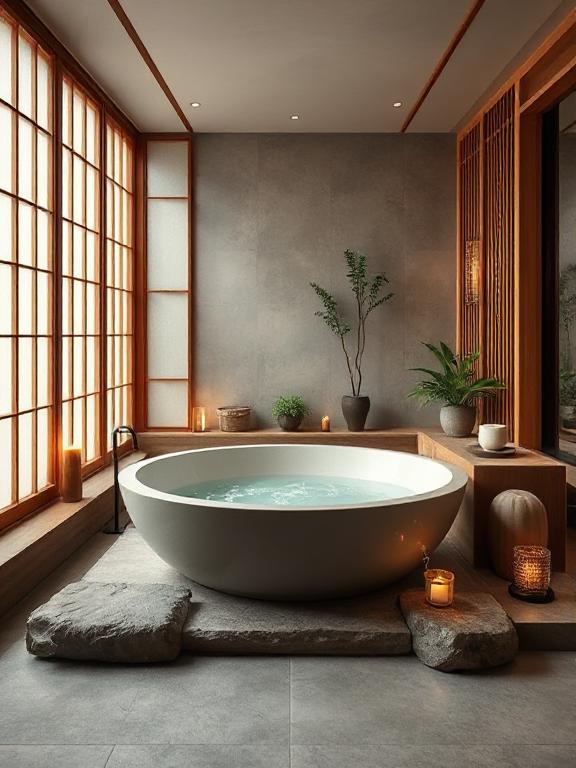Over the years, I have seen countless design styles come and go, but one approach that consistently brings peace and harmony into a home is the Zen-inspired bathroom. A Zen bathroom retreat isn’t just about making your space look stylish—it’s about creating a sanctuary that calms the senses and offers a true escape from the fast pace of everyday life. In a world that often feels overwhelming, I believe every homeowner deserves a space where stress melts away the moment they step inside.
A Zen-inspired bathroom combines natural textures, a muted color palette, and a thoughtful approach to simplicity. Unlike other design styles that might rely on bold statements or ornate details, Zen interiors thrive on balance and subtlety. For me, designing these spaces is about paying attention to the small details that bring comfort, whether that’s the sound of running water, the touch of smooth stone beneath your feet, or the glow of soft lighting at the end of a long day.
By focusing on the right design elements, your bathroom can transform from a purely functional space into a personal retreat that reflects both serenity and timeless beauty. In this article, I will walk you through three unique Zen bathroom inspirations that can guide you in shaping your own space into a calming retreat.
What Makes a Zen Bathroom Retreat?
When I design a Zen-inspired bathroom, I always start by asking one important question: how can this space make someone feel more relaxed the moment they step inside? The answer usually comes down to a few essential principles that form the foundation of Zen design.
The first principle is simplicity. A Zen bathroom should never feel cluttered or overly decorated. Instead, it should create an open and calming atmosphere. Clear surfaces, clean lines, and carefully chosen accessories all play a role in maintaining this balance. The goal is not emptiness, but purposeful minimalism—keeping only what adds value and peace to the space.
Another important element is the use of natural materials. Wood, stone, bamboo, and organic fabrics bring warmth and grounding to the room. I’ve found that homeowners who choose these textures immediately notice the difference—they connect with nature on a subconscious level. Whether it’s a teak bath mat, a stone basin, or bamboo shelving, these touches bring depth and authenticity.
Lighting also plays a vital role. Bright, harsh lighting can instantly disrupt the tranquil atmosphere you’re trying to create. In contrast, soft ambient lighting, perhaps paired with candles or lantern-style fixtures, establishes the calm mood that makes Zen bathrooms so special. I often recommend dimmable lighting so that the space can adapt to different needs—brighter in the morning for energy, softer in the evening for relaxation.
Finally, there’s the influence of water elements. The sound of water has an undeniable calming effect. This can be achieved through a waterfall showerhead, a freestanding soaking tub, or even the subtle trickle of a tabletop fountain. When combined with calming scents like lavender or eucalyptus, the sensory experience becomes deeply restorative.
Understanding these fundamentals is the first step. Now, let’s dive into the first of the three Zen bathroom inspirations, which showcases how these principles come together beautifully.
Inspiration 1: The Natural Stone Spa Retreat

The first Zen bathroom inspiration I want to share is what I like to call the Natural Stone Spa Retreat. This design draws heavily from spa-like atmospheres, where the focus is on using natural stone to anchor the room in calmness and timeless beauty.
Stone is one of the most grounding materials you can bring into a bathroom. Whether you choose sleek marble, textured slate, or smooth river rock, the tactile quality of stone instantly creates a sense of permanence and connection to the earth. I often use stone in multiple ways—on the floor, as an accent wall behind the tub, or even in smaller details like a pebble shower floor. Each application adds texture and dimension while maintaining harmony.
One of my favorite aspects of designing with stone is how it interacts with water and light. When paired with a rainfall shower, for example, a stone backdrop can feel like standing beneath a gentle waterfall in nature. The way light bounces off the uneven textures also creates subtle shadows that add depth, making the space feel more dynamic without overwhelming the senses.
To balance the heaviness of stone, I always recommend layering in softer, natural accents. Think wooden stools, woven baskets, and organic cotton towels. This contrast keeps the bathroom from feeling too cold or rigid. It’s about achieving harmony between strength and softness, much like the balance found in nature itself.
For those who want to take this inspiration further, consider adding plants to the space. A tall bamboo plant in the corner or a few small succulents on the vanity can add a refreshing burst of greenery. Plants not only complement the earthy textures of stone but also improve air quality, making the bathroom feel alive and rejuvenating.
In terms of color palette, I suggest leaning into earth tones. Shades of gray, beige, taupe, and muted green blend seamlessly with stone surfaces. These hues enhance the natural spa-like environment and allow the mind to rest, free from the stimulation of bold colors.
The Natural Stone Spa Retreat is perfect for anyone who wants their bathroom to double as a wellness sanctuary. It’s a space where you can take a deep breath, soak away the stress of the day, and reconnect with a sense of stillness.
Inspiration 2: The Minimalist Bamboo Haven

The second Zen bathroom inspiration I often recommend is the Minimalist Bamboo Haven. If the first idea focuses on grounding through stone, this one highlights lightness, warmth, and sustainability. Bamboo is a remarkable material because it embodies both strength and flexibility, and when used thoughtfully, it can transform a bathroom into a serene retreat.
In my projects, I like to use bamboo in multiple ways: as vanity cabinetry, shelving, flooring, or even as accent wall panels. The natural grain of bamboo has a soft, rhythmic pattern that immediately feels calming. Unlike heavy stone, bamboo brings a sense of airiness to the space, making it ideal for smaller bathrooms that still want to achieve that spa-like tranquility.
The minimalist approach here is essential. Zen bathrooms should not be overwhelmed with unnecessary accessories, and bamboo naturally lends itself to clean, uncluttered design. For example, a floating bamboo vanity with a simple stone basin on top not only saves space but also creates visual openness. Pair this with hidden storage options, and you can maintain a sleek, clutter-free environment.
When designing a bamboo-focused retreat, I always advise my clients to keep the color palette neutral and soft. Whites, warm beiges, and gentle creams pair beautifully with bamboo’s golden tones. To elevate the design, add soft-textured elements like linen shower curtains, cotton towels, or even a woven bamboo bath mat. Each detail should feel light, breathable, and intentional.
For a finishing touch, don’t underestimate the role of natural light. If your bathroom has a window, consider sheer bamboo blinds that filter sunlight softly, casting a warm glow across the room. This creates a calming atmosphere throughout the day, while at night, strategically placed lantern-style lighting maintains the same gentle mood.
The Minimalist Bamboo Haven is an excellent choice for homeowners who value sustainability as much as style. Beyond its eco-friendly qualities, bamboo contributes to a bathroom that feels effortless, clean, and deeply soothing.
Inspiration 3: The Tranquil Japanese Soaking Tub Retreat

The third inspiration takes direct cues from traditional Japanese design and is centered around the soaking tub retreat. Known as ofuro, the Japanese soaking tub is not only a design feature but also a cultural symbol of relaxation, ritual, and mindfulness. Bringing this idea into a modern bathroom creates an intimate and deeply restorative Zen retreat.
Unlike standard tubs, soaking tubs are deeper and designed for full immersion. I often recommend freestanding wooden tubs made of hinoki or cedar, as the warmth of natural wood adds a calming aroma and a touch of authenticity to the space. If wood isn’t an option, a sleek stone or modern resin soaking tub can achieve a similar effect while maintaining a contemporary look.
The placement of the soaking tub is just as important as the tub itself. Ideally, it should become the focal point of the bathroom. I like to position it near a window, allowing bathers to enjoy natural light or even a view of greenery outside. For bathrooms without windows, surrounding the tub with indoor plants or a living wall can recreate that same sense of connection to nature.
Designing around a soaking tub means prioritizing simplicity and serenity. Keep the surrounding area uncluttered, with clean lines and minimal accessories. A low wooden bench, a soft towel ladder, and a few candles are all you need to create a space that feels intentional and soothing.
To enhance the sensory experience, I often suggest incorporating calming rituals like essential oils, bath salts, or soft background music. A Japanese soaking tub retreat is not only about how the space looks but also about how it feels when used—a complete escape that rejuvenates both body and mind.
This inspiration is ideal for those who want their bathroom to serve as a private sanctuary, where daily stress is washed away through both design and ritual.
Tips for Creating Your Own Zen Bathroom Retreat
While each of these inspirations has its own unique qualities, the foundation of Zen design remains the same. If you’re planning to create your own bathroom retreat, here are a few practical tips I always share with clients:
-
Declutter first: Remove unnecessary items and keep only what serves a purpose or adds to the atmosphere.
-
Choose natural materials: Incorporate wood, stone, bamboo, and organic textiles for warmth and authenticity.
-
Focus on lighting: Use soft, layered lighting instead of harsh overhead fixtures. Dimmer switches are invaluable.
-
Bring in greenery: Add plants to refresh the space and create a natural connection.
-
Soften with textiles: Towels, rugs, and curtains in organic fabrics enhance comfort and coziness.
-
Prioritize balance: Every element should feel harmonious—colors, textures, and shapes should work together seamlessly.
By applying these principles, even a small bathroom can be transformed into a calm and restorative retreat.
Common Mistakes to Avoid
Over the years, I’ve noticed that many homeowners make the same mistakes when attempting to create a Zen-inspired bathroom. Avoiding these missteps can save time, money, and frustration.
One common mistake is overdecorating. Zen design thrives on minimalism, so adding too many accessories or decorative objects can quickly disrupt the calm atmosphere. Remember, less is always more.
Another mistake is ignoring lighting. A beautifully designed bathroom can still feel cold or uninviting if the lighting is too harsh. Proper lighting is just as important as the materials you choose.
Lastly, some homeowners make the error of choosing synthetic materials that mimic natural finishes. While these may be more budget-friendly, they often lack the depth and authenticity that real wood, stone, or bamboo bring to the space. Investing in natural materials, even in small doses, makes a significant difference in the overall feel of the room.
Final Thoughts
Designing a Zen bathroom retreat is about much more than style—it’s about creating a personal sanctuary that nurtures peace, balance, and well-being. Whether you are drawn to the grounding qualities of stone, the warmth of bamboo, or the timeless serenity of a Japanese soaking tub, each inspiration offers a pathway to designing a space that truly feels like a retreat.
As a decorator, I’ve seen firsthand the impact a well-designed Zen bathroom can have on daily life. It becomes a space where stress is released, where mornings feel calmer, and where evenings end in relaxation. The beauty of Zen design is its adaptability—it can be achieved in any home, regardless of size or budget, as long as the principles of simplicity, balance, and natural beauty remain at the heart of the process.
If you are considering transforming your bathroom, I encourage you to approach it with intention. Focus on what makes you feel most at peace, and let that guide your design choices. A Zen-inspired bathroom isn’t just a trend—it’s an investment in your well-being and a timeless retreat within your home.

